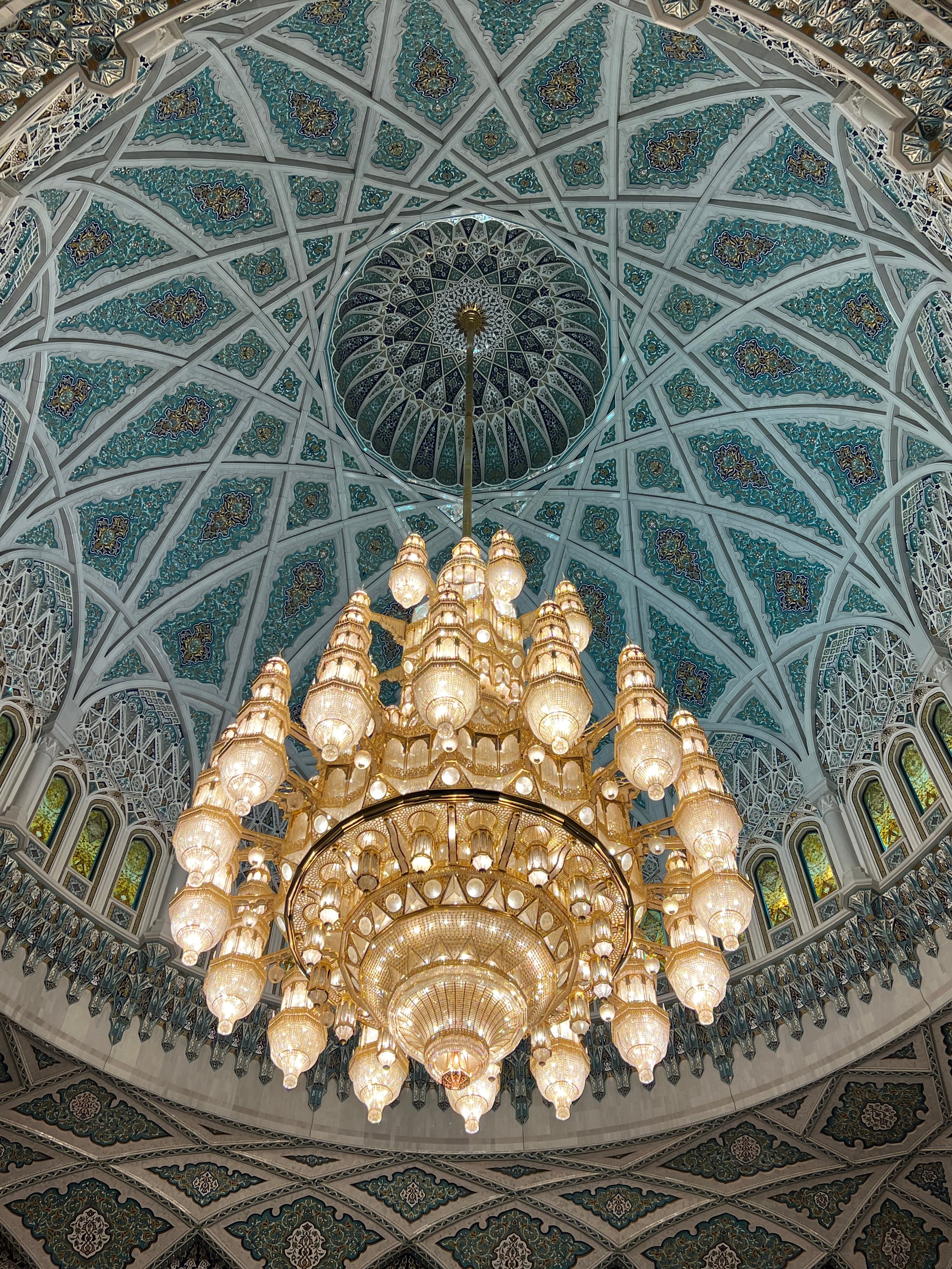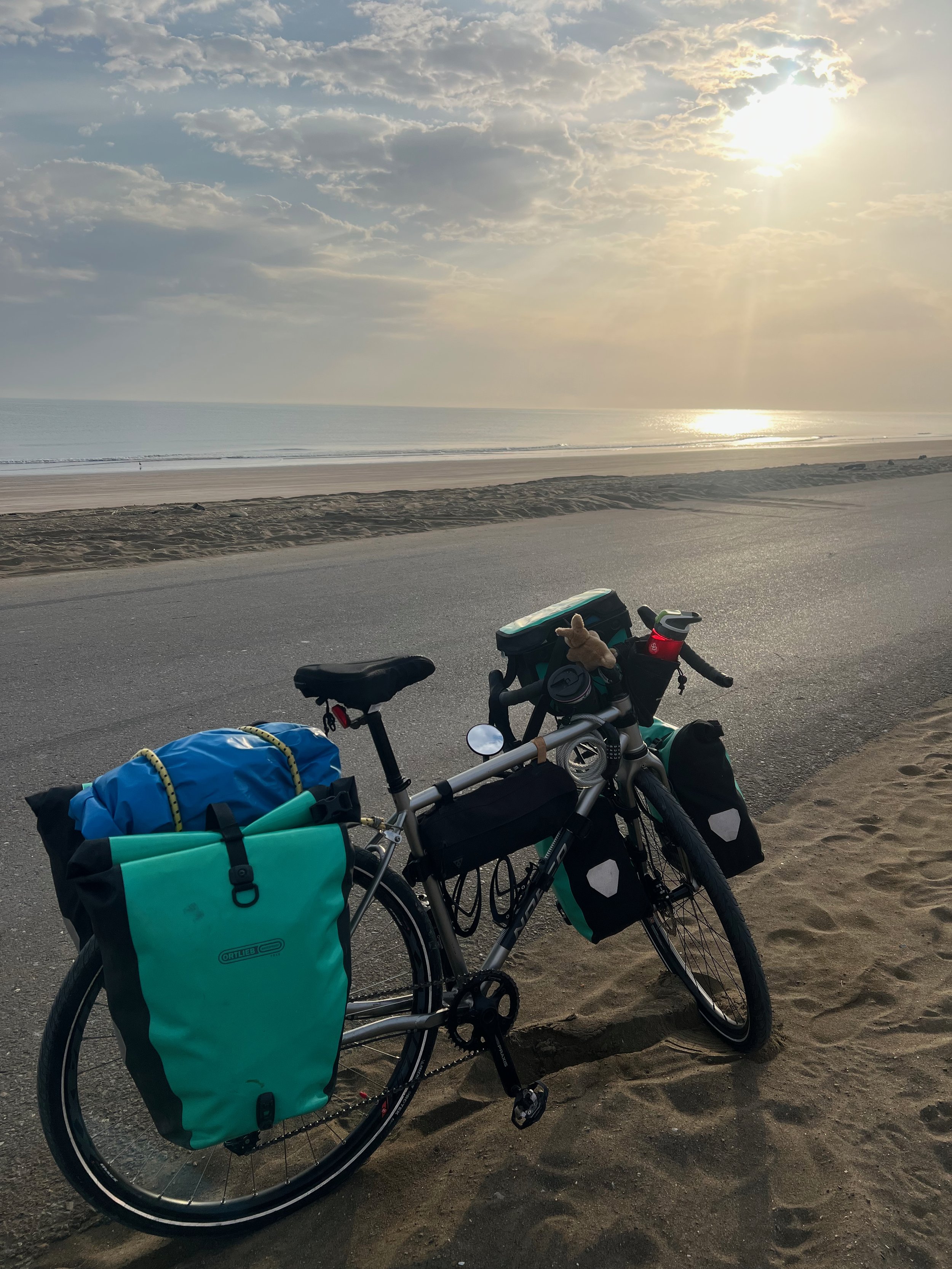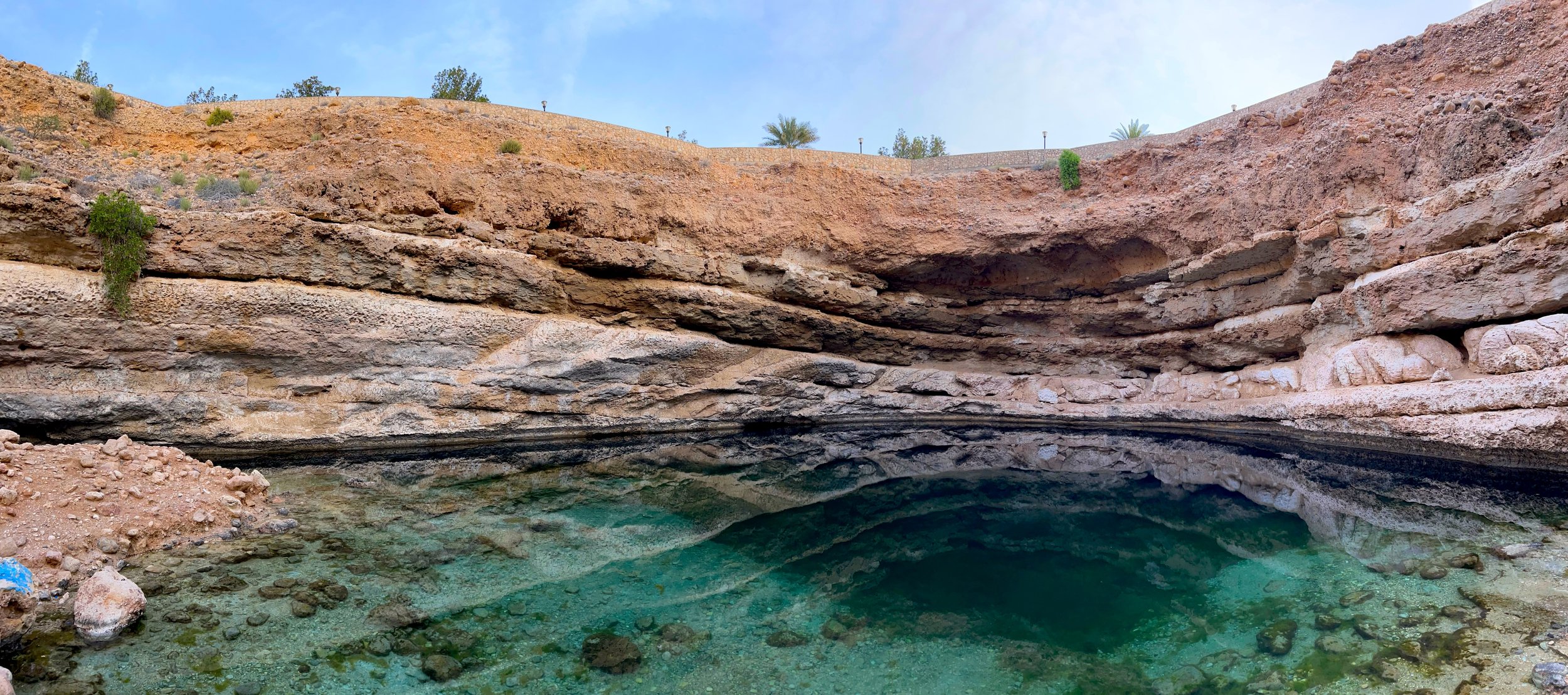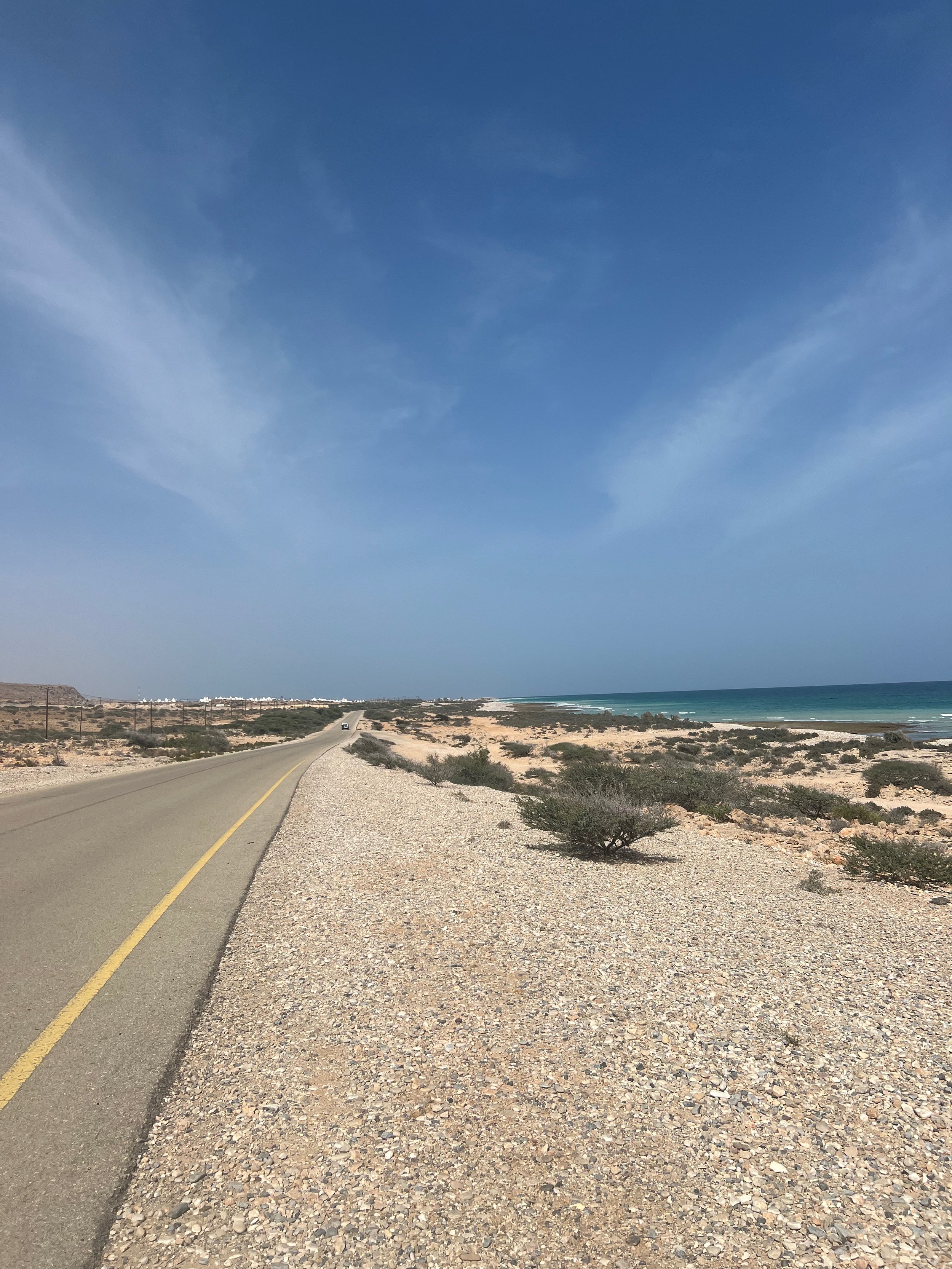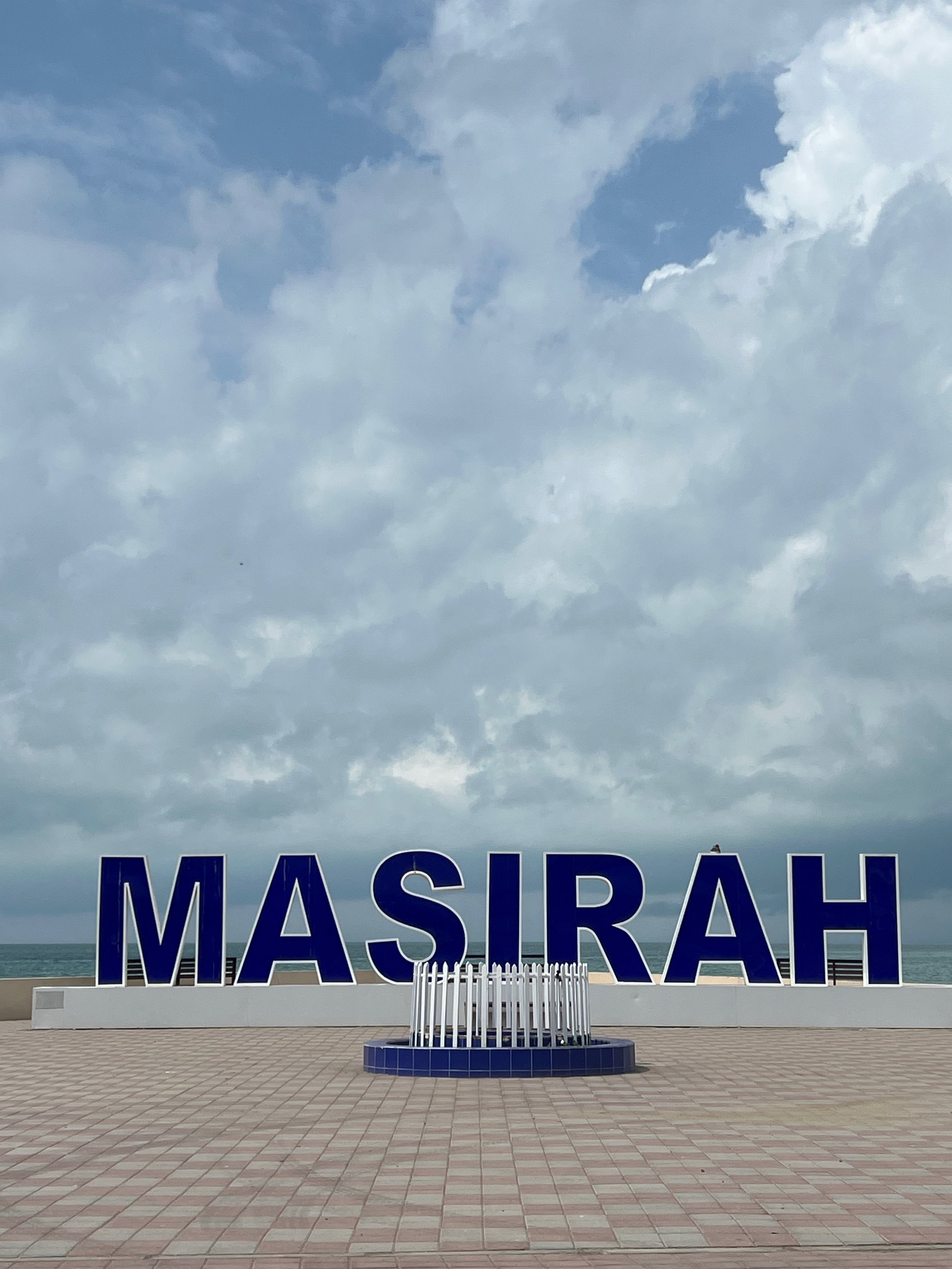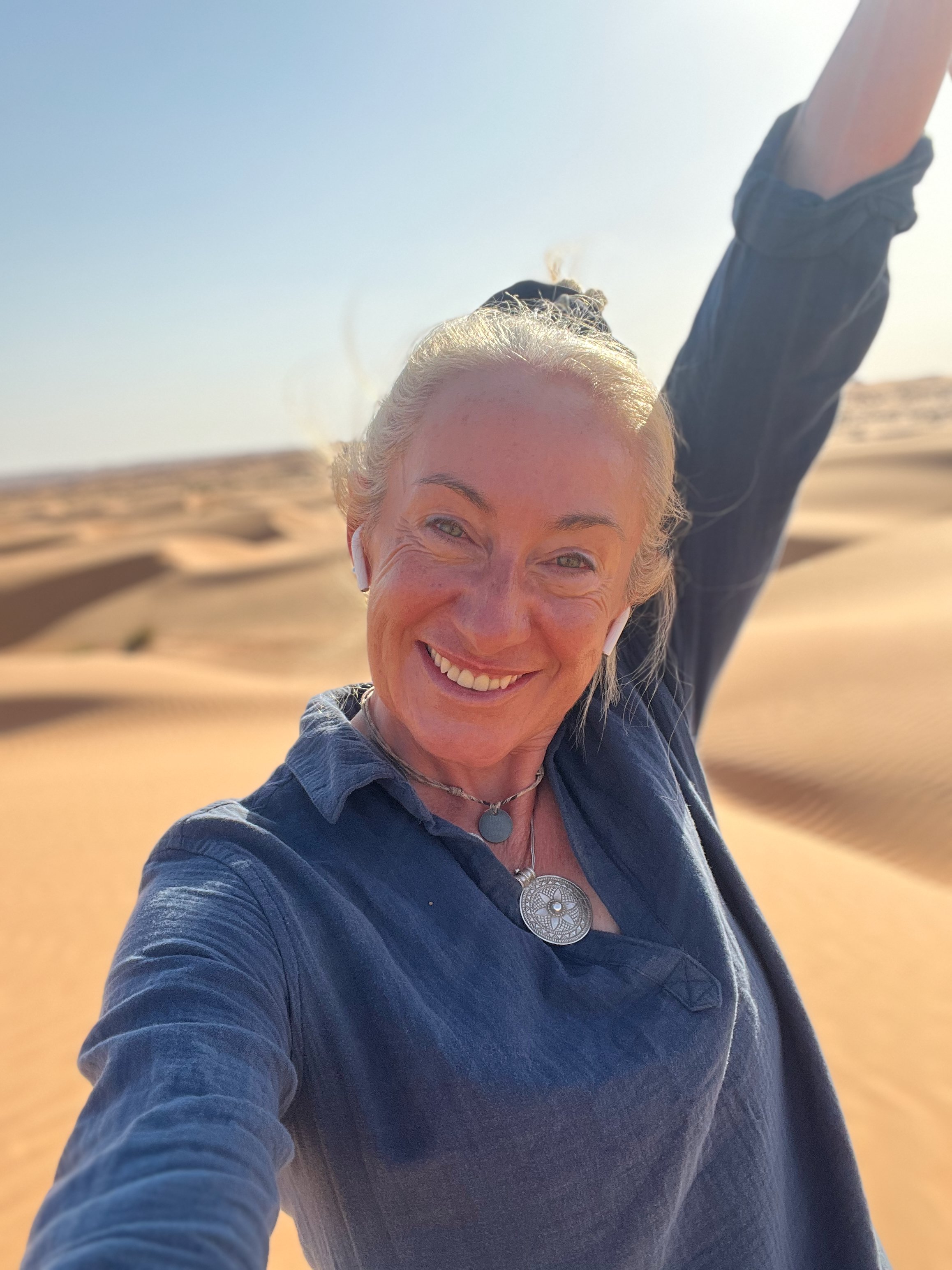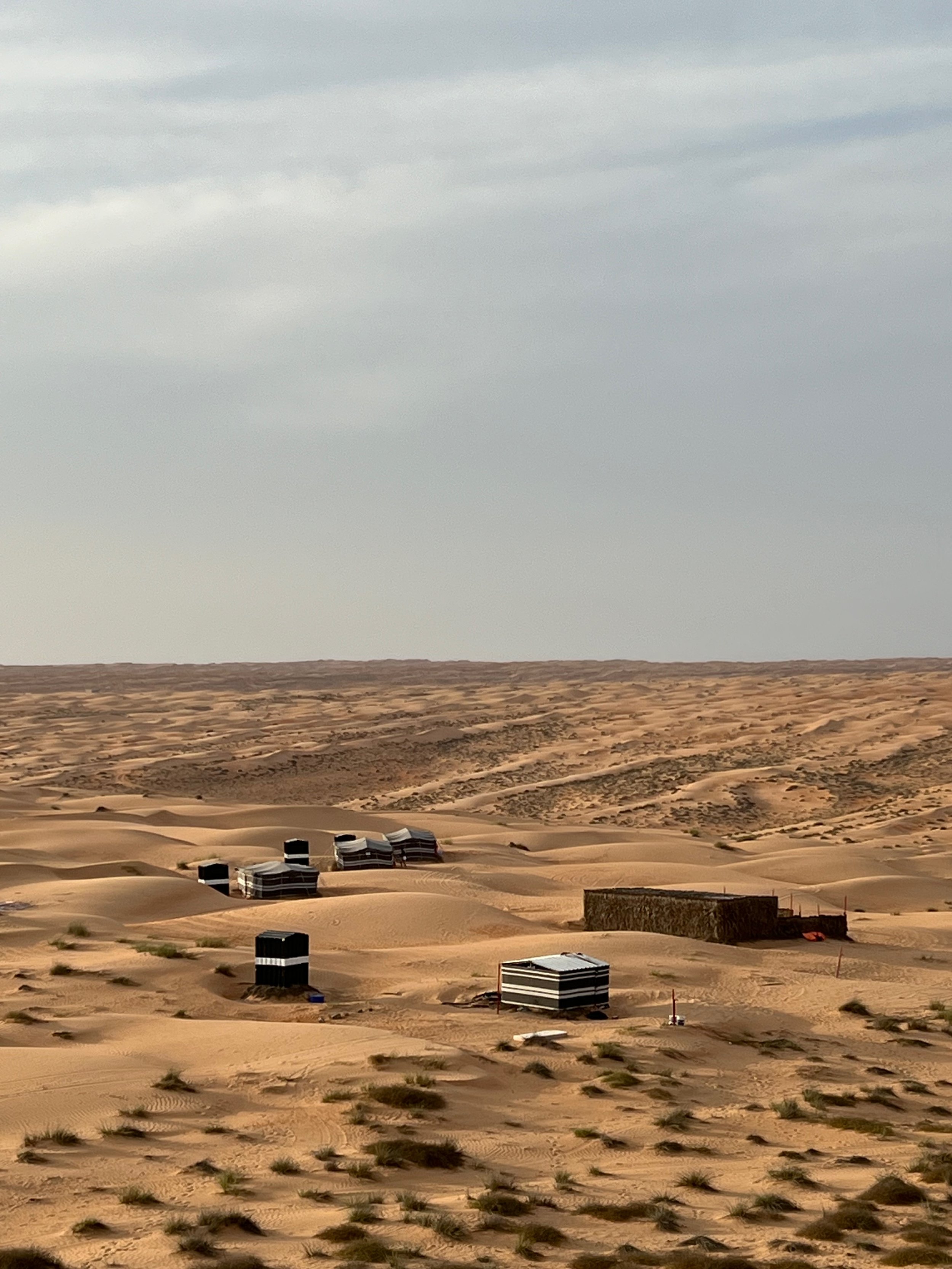Bikepacking Through Oman (aka the Cheesecake Tour of Oman)
The Middle East has been on my bucketlist for a long time. On 26 January, my bags were packed and that’s where I was heading, to go bikepacking in Oman with a few days in Dubai on the way home. I picked Oman based on recommendations, doing some research and the fact that there is quite a lot of cycling there. It ticked lots of boxes.
Oman occupies the southeast of the Arabian Peninsular sharing borders with Saudi Arabia, United Arab Emirates and Yemen. It is the oldest independent state in the Arab World that has shifted and evolved over the centuries. At the start of the 19th century, the Oman Empire extended across the Strait of Hormuz to Iran and Pakistan and down the East Coast of Africa to Zanzibar.
The Empire was divided up in 1856 resulting in the present-day Sultanate of Oman, with its capital, Muscat. And that’s where my adventure started.
Preparation
On arriving in Muscat I gave myself a few days to work through my to-do list to get ready for the cycle. It involved buying supplies and heading to one of the local bike shops to help put my bike, Banjo, back together having been partially dismantled for its travel bag (I didn’t trust myself to get it right). There are a few really good bike shops in Muscat thanks to a rising popularity of cycling there along with some big events including the annual tour of Oman – a multi-stage professional bike race and two 70.3 Ironmans each year.
I made good progress but the voice of self-doubt piped up – I questioned myself – what the hell was I thinking? Bikepacking solo, on a bike that had a fair few issues when cycling across Australia, with no one to problem solve and fix flat tyres with and to be doing this in a part of the world I’ve never been to and knew no one. Hmmm. I felt I really hadn’t thought this through! So I used my to-do list as a distraction and got on with things.
Muscat is a relatively spread-out city, nestled between the rocky arid Hajar mountains and the Gulf of Oman with approximately 1.3 million of the 4.7 million population living here. It is filled with whitewashed houses and a very limited number of high-rises. Unlike its neighbours, skyscrapers are not a thing. In fact, they are forbidden by Royal Decree. One thing they do have are some pretty epic modern upscale malls which is where you find most of the shops.
Sultan Qaboos Grand Mosque
I had some spare time so went to the Sultan Qaboos Grand Mosque. This breathtaking mosque was a gift to the nation from Sultan Qaboos bin Said Al Said to mark his 30th year of reign.
When the project was launched the Sultan’s goals was supposedly to build the most beautiful mosque in the world. It certainly is stunning – the detail in the intricate design is incredible.
Set on 416,000 square metres the mosques is surround by beautifully manicured gardens. It was constructed over 6 years using around 300,000 tonnes of carefully colour-matched Indian sandstone. The building has four minarets, at each corner and the main one close to the dome, representing the five pillars of Islam. The mosque, including the outer space, can hold 20,000 worshippers.
Inside the main hall is the prayer carpet that took 600 women four years to weave. When it was finished it was the largest (now is the second largest) hand-loomed carpet, weighing a whopping 21 tonnes. Above this beautiful carpet, hanging from the dome is a huge chandelier, 14m high, made in Italy. It contains 600,000 crystals and 1,122 halogen bulbs. For some time it was the biggest chandelier in the world until was overtaken by one in the Sheik Zayed Grand Mosque in Abu Dhabi.
It was wonderful walking around this incredible building and the grounds – I’m not surprised that it is the number one attraction in Muscat.
Sohar to Muscat
For now that was the end of the sightseeing. It was time to get pedalling. Outside my hotel, filled with apprehension, I loaded Banjo up. After a slightly wobbly start on the heavy bike, I carefully made my way along the busy roads to the bus terminal. I was heading to Sohar, approximately 230km north of Muscat. It took a bit of negotiating to let me put Banjo on but they agreed and we were off. After 3 hours we arrived in Sohar and cycled to the hotel for the night.
The goal was to use the first few days cycling back to Muscat, get into the swing of things and iron out any issues with Banjo.
Day 1 was a dream. The first 20kms were on a quiet road next to the ocean - with the cool morning air and only a few people around, it was heaven.
At one point I stopped under the shade of a tree outside a house to check the route - despite it being winter here temps were in the high 20s/low 30s (degrees Celcius). In summer the thermometer regularly hits 40C, up to 50C as you go inland and to the desert.
The owner of the house came out - a local headmaster - and generously invited me in for a cold drink and to meet his family, one of whom is an English teacher. They very much reminded me of the hospitality and generosity of the people of Sudan. I was given cold drinks, the aircon was popped on, they took me to see their horses and then gave me lunch – a huge serving of delicious fish, rice and salad.
They even gifted me some perfume (being only day 1 I don’t think this was a subtle hint).
I enjoyed chatting and laughing with the women in the family while surrounded by all their gorgeous kids. It was one of the things I was mostly looking forward to on this trip - the people I would meet. After a wonderful few hours, I reluctantly had to say goodbye and get going.
Over the next two days I chose a more direct route toward Muscat, following the motorway on the service road next to it. Along the way there was more kindness including not being allowed to pay for a cold drink at a supermarket, people offering me water and lots of waving and thumbs up.
I discovered a slight issue with the Banjo – I couldn’t get into the easiest gear. With some climbing ahead of me and having zero bike mechanic skills, I made the call to pit stop in Muscat. As it was Friday, all the shops were shut, so I booked into a hotel for a couple of nights and the next day got Banjo fixed.
Muscat to Sur
It was tough to leave the lovely hotel. The apprehension to be heading off into the unknown, knowing that things were going to be more remote, made leaving that much harder. I knew once I got going I’d be fine. Which I was, once out of Muscat. The roads were busy but it wasn’t too long before the traffic thinned out.
The climb out to Al Amerat wasn’t as bad as anticipated, which was a relief. While I had been on the bike in preparation for this trip, I was definitely not prepped for big climbs. What followed was a wonderful ride through the arid, rocky hills. It was still a main road but had a big hard shoulder and not much traffic.
I was blessed with a tailwind, and with just one more climb it was downhill to Quriyat, a destination I had expected to take a day and a half to cover the 110km. I headed to the beach to find a spot to camp. One of the many great things about Oman is that you can camp pretty much anywhere.
The next few days were shorter, taking the time to explore the sights.
Bimmah Sinkhole
First stop was Bimmah sinkhole. I arrived sweaty and huffing and puffing after a fair bit of climbing to get there. Khalid, who was managing this place, looks after the visitors, particularly solo travellers. He showed me where I could put Banjo, the bathrooms and a shower I could use. He told me to take my time, enjoy the space and to relax. I reminded myself there was no need to rush, and with Khalid’s words in my ears, I took a slow deep breath and relaxed.
Bimmah Sinkhole is a 20-meter-deep turquoise lake measuring about 50 by 70 meters. With steps down to it, visitors are welcome to take a swim. It was divine stepping into the cool, crystal-clear water after the hot ride.
Khalid invited me to chill out on a mat under a tree and gave me my first taste of Omani coffee (lightly spiced) and some dates. Soon I was joined by two other solo female travellers, Ola and Samia. We all decided to camp there for the night, Khalid generously made us dinner and we all enjoyed some great chats and lots of laughs.
Wadi Ash Shab
Next was Tiwi and Wadi Ash Shab. Wadi is the Arabic term traditionally referring to a river valley. In some instances, it refers to a riverbed containing water only when heavy rain occurs. But many are filled with water all year round and are beautiful spots to visit and swim in.
There was a short boat ride to the start of a 40min walk into the Wadi. Along the way, I got chatting to one of the guys who works there who’d just finished for the day and was heading up for a swim.
He invited me to join him on a walk to the top of the wadi - a local’s route. It was very tricky in sections with narrow paths next to sheer drops and clambering up, over and down limestone boulders questioning if this was such a good idea after all. It turned out it was – before too long we were swimming in the blue pools above a small waterfall which we jumped off.
Then it was swimming down through a cave and more pools filled surrounded by limestone boulders and towering steep sandstone cliffs. It was stunning!
From Tiwi it was Sur, initially along the beautiful quiet coastal road before getting back on the highway.
Sur
In Sur I sniffed out an amazing coffee shop called Brew Oz – when I saw the name, I had to go there. The coffee was perfection and they had the bonus of cheesecake drizzled with Nutella! This was the beginning of the cheesecake tour of Oman, a summary of which is below. Cheesecake is one of my favourite treats, so finding an endless supply here was a bonus (and one I could justify with all the cycling)!
While in Sur I popped into the Dhow factory and got to see the dhows (traditional Arab sailing boats) being built and the history behind them and Sur. Going back to the 6th century Sur had become an important trade centre with East Africa. Boats naturally were vital and a thriving ship-building industry began. Today they are used far less but this factory remained in the same family for hundreds of years and works to the traditional techniques.
As well as checking out the factory I climbed up toward the Al Ayjah Watchtower for a view of Sur. There was also a return visit to the epic coffee shop for more coffee and cake! There’s plenty more to see here, but I was happy to chill and take things easy.
Sur to Duqm
With fresh legs, a tummy full of cheesecake and the bonus of a tailwind, I was able to put in a couple of big days out of Sur. I was keen to make the most of conditions before the forecast southerly hit.
The rocky hills gradually gave way to desert. There were some lovely stretches with the ocean on one side and desert on the other. It wasn’t long before I spotted my first camels.
It was stunning and a lovely ride with an undulating road and villages few and far between. I’d loaded up with plenty of water – running out of water was a concern, but as the trip went on I realised I didn’t need to worry as drivers regularly stopped to see if I needed more water. One family gave me some biscuits and water and then came back with juice and chips (aka crisps).
Camping in the desert areas was wonderful – watching the sunset over the dunes and waking up to see the sun come up over the ocean. The headwinds hit but I’d covered 250km and only had 40km to reach Shannah Port for the ferry over to Masirah Island. Having cranked out nearly 290km in 2.5 days I was ahead of schedule so had time for this detour.
Masirah Island
It was just under an hour to the island. With even stronger southerlies and a potential storm forecast I decided to have two days on the island.
The island is 95km long and between 12 and 14km wide with about 12,000 people living here. It’s popular with kite surfers and windsurfers, particularly in summer when the wind and waves pick up.
The Brits had a military presence here from the 1930s to the 1970s and it was only opened to tourists in the 90s. The middle of the island has rocky hills and the coastline is mostly sandy beaches. These are an important hatching ground for loggerhead sea turtles. Sadly I was here at the wrong time of year to see them.
After a restful couple of days, and enjoying plentiful seafood, it was time to get back to the mainland and head to Duqm. The days got tougher with less favourable winds and roads with not much of a hard shoulder and plenty of trucks flying past. But at least here they don’t have road trains. What never failed to make me smile was seeing camels in utes.
The scenery also made for a good distraction with a mix of dunes and rocky hills in the distance as well as vast desert plains. One of the highlights was a wonderful lorry driver who skilfully pulled off the road and brought his large truck to a quick stop when he saw me. He jumped down and brought me a chilled protein drink. Oh the joy! He said he always stops for cyclists and gives them a drink - usually one of these. What a legend.
He was from India and one of about 2 million of the 4.7 million living in Oman who are expats, with the majority coming from Bangladesh, India and Pakistan. Non-Omanis also make up four-fifths of the labour force.
Within 2.5 days I arrived in Duqm, which marked the end of the first section with over 1,000kms covered. I treated myself to a celebratory coffee and delicious cheesecake (of course) before the bus trip back to Muscat.
Muscat
There I had a couple of days to plan and prep the next section and enjoy some sightseeing.
Muttrah
First stop was Muttrah, a stunning old part of Muscat and a popular tourist stop. It sweeps around a beautiful seafront corniche, with the docks dominated by a couple of huge superyachts. The largest(in the picture below) was formerly owned by Sultan Qaboos, but was sold to the Qatar Royal Family. It’s estimated to be worth US$600m and costs a staggering US$60m to run each year!
I wandered up to the old Portuguese Fort (built in 1507) for some stunning views. Then it was a stroll through the labyrinth of narrow alleyways that make up the extensive and renowned souk. The smell of frankincense and perfume hangs heavy in the air. The colourful shops sell everything from pashminas to perfume, spices, silver and gold jewellery, traditional clothing and more. Haggling is expected and adds to the experience. My shopping was constrained by the fact that my luggage was already close to the allowance…
Meeting Mark Evans MBE
While in Muscat I had the great honour of meeting Mark Evans MBE. Mark has completed many expeditions in some extreme conditions and has lived in the region here for over 20 years.
He has crossed the Empty Quarter, completed an 80-day expedition with camels across Oman, kayaked 1700km along the coast of Oman, spent 12 months in the Arctic and more.
Along the way he has raised millions for charity, set up Outward Bound in Oman, and created Connecting Cultures recognised by the UN as a leading civil society initiative. He was recognised with an MBE for his services to intercultural understanding. Total legend! It was fantastic to meet him and hear about his achievements. He generously gave me a copy of one of his books.
Muscat to Nizwa
With the prep done it was time to get pedalling again. I was heading inland to Nizwa over a couple of days. Negotiating some roadworks out of Muscat was challenging, as was the climbing. At the end of a long first day, I was struggling to find a spot to camp. An Omani gentleman pulled over to see if I was ok. He kindly said he would show me somewhere I could stay for the night, so I followed him into Imti, a nearby village where he lived.
He showed me to a soccer club he was involved with and the club board room where I could sleep – perfect! Saved having to put the tent up and gave me access to bathrooms. He suggested a walk into the village to the local café and old town. I was shattered and was tempted to just crash, but decided to follow his advice. And I’m so glad I did.
The café was a little oasis and an unexpected gem. Great coffee and cheesecake in a beautiful outdoor setting with the noise of gently flowing water from the falaj that runs through the back of it. (A falaj is a water channel forming an irrigation system, with some in Oman dating back to 500AD.)
Then I checked out the old village – I was in for another surprise. It’s an ancient village and archaeological site made of dry stone and adobe and wonderful architecture. Work has been done to restore the village and it made for a perfect spot for a stroll as the sun was setting.
Nizwa
The next day I made it to Nizwa, one of the oldest cities in Oman and the former capital. Most tourists to Oman seem to head here. It’s a stunning old city with narrow streets and is surrounded by a thick palm oasis and is known for its huge fort and castle and 2km long high wall as well as a large souk.
It has deep connections to the root of Islam. A handwritten letter from Muhammad in 630 asked the locals of Nizwa to convert. The locals sent a return delegation to Medina and embraced Islam. Muhamad then sent a tutor to teach the new Muslims the fundamentals of the religion.
The fort was built in the 1600s. The fort is connected to the castle that was first built in the 8th century and expanded in 17th century. I visited when it opened at 8am and had the place to myself for the first half hour.
I then walked along the high wall, through the narrow streets and to the bustling souk with vendors selling jewellery, pottery, vegetables, meat, spices, dates, gold and silverware. Plus visited a few fabulous cafes. It was perfect for a chilled day of sightseeing and coffee drinking.
Wahiba Sands
After a day off the bike, it was time to head to somewhere I’d been looking forward to all trip – Wahiba Sands, a 12,500 square metre desert in the heart of Oman. Getting there included my longest day on the bike for this trip – 136km with more climbing. That night I found a camp spot away from the main road and seemingly away from people.
However, at 2am I was woken by lights being shone into my tent and male voices. Pulling up my eye mask and taking out my earplugs (looking an absolute treat I’m sure) I peered out to see what was going on. There were two Omani men. “What’s the problem,” I asked. “No problem,” they said. Ok, a good start.
What transpired was they were concerned and wanted to offer somewhere more comfortable. Though this took a little time to work out with the language differences. At one point they engaged good old Google translate – ‘warm problem’ came up on the screen– ah ok, they were concerned I’d be cold. And they were saying “bathroom'“, “eating”. I assured them I was fine and they eventually gave up, I think somewhat bemused that I would turn down somewhere far more comfortable.
The following day I made it to the meet point for my stay in the desert. Cycling and sand dunes don’t mix. Even if they did there’s not a chance of finding Clouds Desert Camp where I was staying.
Salim, the camp owner and host, met me in his 4WD and we were quickly off for an exhilarating ride into the desert. The camp has just three guest tents and a communal area to sit, to eat and to relax. Perfect when the day gets too hot to be out in the desert.
I was there in plenty of time to climb up into the dunes and watch the sunset. It was blissful. That night, with the fellow guests, we enjoyed dinner and chats around a campfire.
The next morning I got up to see the sunrise across the desert. Sunrise is about 6:30am so it wasn’t a brutally early start. It was so peaceful - no wind, no birds, cars, people - just silence. It was pretty special, being there sitting, watching and walking through the dunes.
The rest of the day was spent mostly thinking, reflecting, journaling, and chatting with Salim, learning more about Bedouin life.
Then it was time to bid farewell to the desert and head to Sur. With a late start on the bike I expected to arrive there the next day. But the magic combination of fairly flat roads, very favourable tailwinds and fresh legs I got the 116km done to Sur.
The last days
That marked the end of the bikepacking with a total of 1570kms covered (with no punctures!). I got a bit emotional as I reached the end - happy to have done this and the amazing experiences on the way. But also sad that it was done - I didn’t feel ready for it to be over.
There’s an amazing sense of freedom, cycling with everything you need with you. It takes you at a pace you can cover good ground, but be totally immersed in the surroundings and not miss a thing. You also get to have many more opportunities to meet and talk to people. It makes the sore bum and tired legs worth it!
As the trip had gone on, my confidence on the bike (and in the bike itself) had increased, and with it, a love of bikepacking grew and kindled lots of ideas for future trips.
But for this trip, it was a wrap for the cycling and the cheesecake tour. Talking of which - can you guess how I celebrated the finish? Yep, a final serve of cheesecake! Damn, it was good.
It was another bus trip and then the last couple of days which included a visit to the Royal Opera House - another popular tourist spot. It was also another gift by the former Sultan, Sultan Qaboos bin Said, a classical music and arts enthusiast. Some of the greatest have performed here: Placido Domingo, Andrea Bocelli, the London Philharmonic Orchestra, the American Ballet Theatre and more. It is another architecturally stunning building. Visitor tickets automatically include a tour of the building.
The last stop was a snorkeling trip to Daymaniyat Islands Nature Reserve, a UNESCO listed archipelago of nine islands lying about 18km off the coast. It is a nationally, regionally and internationally important conservation area in which thousands of marine birds nest in summer.
There are also coral reefs, tropical fish, endangered species of turtles, dolphins, whales and more. It makes a wonderful spot for snorkelling and scuba diving and after the 50-minute boat ride to get there, I got to enjoy seeing many of the fish and turtles.
I was sad to be leaving Oman. There were other places I’d love to have seen – Jebel Shams, Jebel Akdhar, Salalah, Wadi Ban Khalid, Musandam and more. Enough for another trip here. But for this trip, it was a wrap.
I highly recommend Oman as a place to visit. I have put together a separate post on general information on visiting Oman, with some suggestions and tips based on my trip. You can read it here.
Sarah x
PS I want to extend some big thanks. While I was on my own, I wasn’t alone. I had my support team back in Aus – Debbie Midwinter and Sue Watts. While on the road I was checking in with them daily. And they were ready to jump into action if there were any problems. I am so grateful to them both - knowing they were there and had my back made such a difference. Like having two guardian angels!
And there was also Dave. If you’ve read my book, you’ll know all about him. He was keeping an eye on things, and gave me advice and support along the way. He was also there if there were any major issues. Thank you Dave, you’re a legend.





